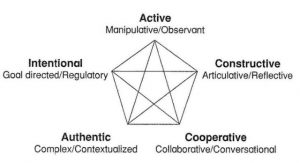I think my definition of technology would connect most closely to Muffoletto (1994) and the idea that technologies are a way of acting. Connecting to the definition of technology that started for me in ETEC 540 and that at a certain point in time a pencil was the current form of technology. The pencil allowed stories and ideas to be recorded. So what is an educational technology tool today may not be the most influential tomorrow but, just at the printing press allowed the spread of information through print, today’s technology is the act of creating and disseminating information and ideas in a faster way.
Keeping that definition in mind, I find myself returning to the visual below when I think of a TELE in my classroom. I think this graphic shows how as our understanding grows we get ready to take the next step and create more authentic use of educational technology in the classroom. Any time I prepare to bring in a technology I ask myself “can I do this with a pencil and paper?” if my answer is yes then I know I am at substitution. While there is a time and place for enhancing learning through technology I think the real value of technology appears when our lessons get into the transformation phase of SAMR.

References:
All Things SAMR Model by Blanca Lemus. (2016). Thinglink.com. Retrieved 29 May 2016, from https://www.thinglink.com/scene/661408904193769474
Muffoletto, R. (1994). Technology and restructuring education: Constructing a context. Educational Technology, 34(2), 24-28.
